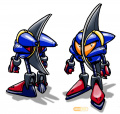Difference between revisions of "Sonic X-treme (Project Condor)"
From Sonic Retro
(→History) |
(→History) |
||
| Line 24: | Line 24: | ||
While Senn did eventually arrive and try to clear things up, Nakayama was furious, and demanded that game be built on the work provided by Christina Coffin and her boss engine{{intref|Sonic Xtreme FAQ by Chris Senn (2008-12-23)}}{{intref|Mike Wallis interview by PACHUKA}}. With little choice but to follow Nakayama's demands, [[Mike Wallis]] gathered his team and sequestered them away from the politics at the STI headquarters, so they could focus on the project in the hopes of having it done by Christmas. | While Senn did eventually arrive and try to clear things up, Nakayama was furious, and demanded that game be built on the work provided by Christina Coffin and her boss engine{{intref|Sonic Xtreme FAQ by Chris Senn (2008-12-23)}}{{intref|Mike Wallis interview by PACHUKA}}. With little choice but to follow Nakayama's demands, [[Mike Wallis]] gathered his team and sequestered them away from the politics at the STI headquarters, so they could focus on the project in the hopes of having it done by Christmas. | ||
| − | Knowing time was not on their side, Wallis turned to then-new CEO of Sega of America [[sega:Bernie Stolar|Bernie Stolar]], asking him for the | + | Knowing time was not on their side, Wallis turned to then-new CEO of Sega of America [[sega:Bernie Stolar|Bernie Stolar]], asking him for the technology being used for ''[[NiGHTS into Dreams]]'', the ''Sonic X-Treme'' team in desperate need of the development tools within. In a few days, a level editor arrived, and for the next two weeks the team became familiar with it{{intref|Mike Wallis interview by PACHUKA}}. However, development using this editor was forced to cease, with Willis claiming that Yuji Naka was against the technology being used and was threatening to quit were it given to the X-treme developers, Sega bending to Naka's wishes and forcing the team to start back at square one{{intref|Mike Wallis interview by PACHUKA}}. |
| + | |||
| + | This version of events is disputed by Naka{{ref|https://web.archive.org/web/20220707163130/https://twitter.com/nakayuji/status/1545081556019998720}}. While the developers may have had access to level editors, Naka does not recall any requests for the ''NiGHTS'' game engine{{ref|https://web.archive.org/web/20220707164425/https://twitter.com/nakayuji/status/1545086182207266817}}, and suggests the two project would be incompatible anyway, due to NiGHTS being built with assembly language and ''X-treme'' using C. Naka also suggests that the code powering ''NiGHTS'' was designed solely for ''NiGHTS'' (it being common at Sega for code to be written specifically for one game), and would be difficult to adapt for other projects. He also suggests documentation was poor, so the code would be very difficult to understand, to the point where he even discouraged [[sega:Makoto Uchida|Makoto Uchida]] from trying to port the game when the [[PlayStation 2]] version was in development{{ref|https://web.archive.org/web/20220708174502/https://twitter.com/nakayuji/status/1545463852447346688}}. | ||
Desperate to make the deadline, programmer Christina Coffin moved into the development headquarters, working almost non-stop, the few hours of sleep being had in a cot within the office. The strain of the project became simply too much, Christina being overtaken with pneumonia in August of 1996. With doctors saying she only had months to live if she kept this up, Coffin was forced to bow out of the development cycle. With its lead programmer out of commission, Mike Wallis was forced to tell management that the game would not be completed in time for Christmas. | Desperate to make the deadline, programmer Christina Coffin moved into the development headquarters, working almost non-stop, the few hours of sleep being had in a cot within the office. The strain of the project became simply too much, Christina being overtaken with pneumonia in August of 1996. With doctors saying she only had months to live if she kept this up, Coffin was forced to bow out of the development cycle. With its lead programmer out of commission, Mike Wallis was forced to tell management that the game would not be completed in time for Christmas. | ||
Revision as of 08:03, 9 July 2022
| Sonic X-treme |
|---|
| System(s): Sega Saturn |
| Publisher: Sega |
| Developer: Sega Technical Institute |
| Genre: Action |
| Status of prototype(s): Early prototype dumped |
"Project Condor" is an iteration of Sonic X-treme, which came into being after a presentation of the game displeased Sega president Hayao Nakayama. Project Condor was a substantial re-write of the game, with lead programmer Ofer Alon being dropped in favour of Christina Coffin, and director Chris Senn also being moved from the project.
A 1997-07-18 prototype is the only known surviving build of this iteration of the game.
Gameplay
This iteration of the game stems from Christina Coffin's "boss engine", which gave Sonic full 3D movement around a small arena. This engine had been shown in a very early state at E3 1996 and was relatively well received, and while further development added actual bosses, it was not designed for full 3D platforming, as Project Condor would seemingly demand.
Other than a few screenshots, little is known how far this iteration of the game progressed before being cancelled, although the 2D sprites of Sonic were replaced with 3D models, and the scenery became more colourful. It is assumed that some ideas from the original Sonic X-treme carried forward, though as so little of it was set in stone, it is hard to know for sure.
History
In March 1996, a group of representatives from Sega of Japan (including then-president Hayao Nakayama) visited the Sega of America branch, expecting to see a presentation of the work done so far to Sonic X-treme. However, confusion (not least because neither Ofer Alon nor Chris Senn were even in the meeting at the time[1]) led to two presentations, one of a very early build of Ofer's engine on PC, and another of the Point Of View iteration, itself also early.
While Senn did eventually arrive and try to clear things up, Nakayama was furious, and demanded that game be built on the work provided by Christina Coffin and her boss engine[1][2]. With little choice but to follow Nakayama's demands, Mike Wallis gathered his team and sequestered them away from the politics at the STI headquarters, so they could focus on the project in the hopes of having it done by Christmas.
Knowing time was not on their side, Wallis turned to then-new CEO of Sega of America Bernie Stolar, asking him for the technology being used for NiGHTS into Dreams, the Sonic X-Treme team in desperate need of the development tools within. In a few days, a level editor arrived, and for the next two weeks the team became familiar with it[2]. However, development using this editor was forced to cease, with Willis claiming that Yuji Naka was against the technology being used and was threatening to quit were it given to the X-treme developers, Sega bending to Naka's wishes and forcing the team to start back at square one[2].
This version of events is disputed by Naka[3]. While the developers may have had access to level editors, Naka does not recall any requests for the NiGHTS game engine[4], and suggests the two project would be incompatible anyway, due to NiGHTS being built with assembly language and X-treme using C. Naka also suggests that the code powering NiGHTS was designed solely for NiGHTS (it being common at Sega for code to be written specifically for one game), and would be difficult to adapt for other projects. He also suggests documentation was poor, so the code would be very difficult to understand, to the point where he even discouraged Makoto Uchida from trying to port the game when the PlayStation 2 version was in development[5].
Desperate to make the deadline, programmer Christina Coffin moved into the development headquarters, working almost non-stop, the few hours of sleep being had in a cot within the office. The strain of the project became simply too much, Christina being overtaken with pneumonia in August of 1996. With doctors saying she only had months to live if she kept this up, Coffin was forced to bow out of the development cycle. With its lead programmer out of commission, Mike Wallis was forced to tell management that the game would not be completed in time for Christmas.
Though the official word was the project had been postponed, those involved knew the game had finally been canceled after years of production. To fill its place, a hastily-done port of Sonic 3D: Flickies' Island with enhanced graphics, a new special stage, and redone music was released on the Saturn that year. The advertisement money that was intended for X-Treme was devoted to Sonic Team's NiGHTS into Dreams, which became the Sega Saturn's top seller that Christmas, the port of Flickies' Island being second.
Screenshots
An unknown level (possibly Red Sands) showing off the 3D model of Sonic used at this stage of development.
Production credits
- Christina Coffin
- Dean Ruggles
- Jamie Bible (contract programmer)
- Jason Kuo
- Mark Kupper
- Mike Wallis
- Richard Wheeler
- Hirokazu Yasuhara
- Source: Sonic Xtreme Compendium
References
- ↑ 1.0 1.1 Sonic Xtreme FAQ by Chris Senn (2008-12-23)
- ↑ 2.0 2.1 2.2 Mike Wallis interview by PACHUKA
- ↑ @nakayuji on Twitter (Wayback Machine: 2022-07-07 16:31)
- ↑ @nakayuji on Twitter (Wayback Machine: 2022-07-07 16:44)
- ↑ @nakayuji on Twitter (Wayback Machine: 2022-07-08 17:45)
| Sonic X-treme | |
|---|---|
|
Main page (Point of View|Project Condor|SonicPC) |
show;hide
|















